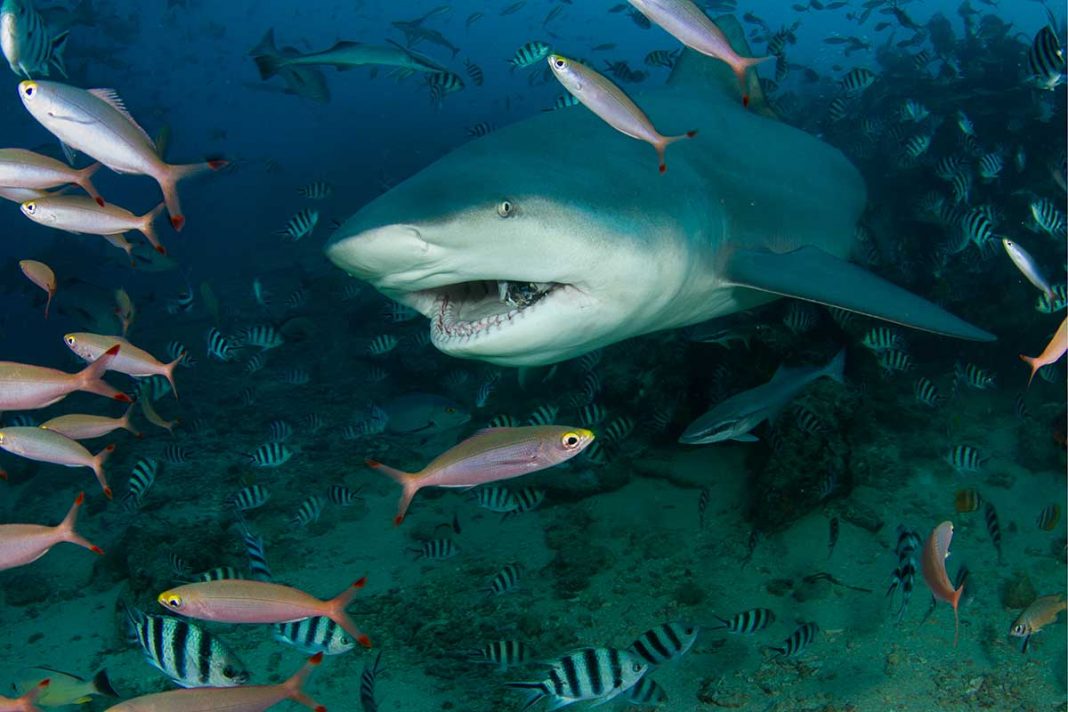HULL, QUEBEC – Hazardous invasive species experts with the Canadian government have recently approved a pilot project to both control the spread of invasive grass carp in Lake Huron and support biodiversity by re-introducing 6,000 carcharhinus Algonquin, an ancient species of freshwater shark that once thrived in the waters of this region.
“Absolutely, this is an excellent idea,” said retired fisheries and wildlife biologist and Spring Bay resident Mike Wilton, who worked with the Ontario Department of Lands and Forests and the Ministry of Natural Resources for more than 35 years. Although the target of 6,000 in this first year might not seem like a large number, there are plans to see how the project goes and increase the numbers in future years if desired.
“Population control (of invasive species) with a top predator is an excellent method and it would greatly help the tourism industry because we would be developing a shark fishery, which is already very popular in the oceans,” Mr. Wilton added.
Physical changes to the landscape over thousands of years reduced the suitable habitat for the shark species. About 4,000 years ago where Lake Huron is now, a massive water body called Lake Algonquin covered a large area (including Manitoulin Island, which was then underwater after the retreat of the last ice age).
Years of melting ice created optimal conditions for major rivers to start up, including the modern-day Ottawa River which was once a massive, deep waterway that linked Lake Algonquin with the St. Lawrence River. Researchers believe this was the way carcharhinus Algonquin navigated to this part of the continent.
All indications suggest that carcharhinus Algonquin began as a shark species which lived in the oceans but required freshwater to spawn, not unlike salmon. In another parallel to these sharks, salmon were first introduced into the Great Lakes in the 1960s to control stocks of non-native alewife. Although most salmon require a mix of fresh and saltwater at various parts of their life cycle, populations such as the Great Lakes salmon can exclusively live in fresh water.
“Picture what happened when Lake Algonquin developed: as the glaciers melted and flooded the area, there would have been open access to the Atlantic Ocean at that time. That’s probably how the sharks first got here,” said Mr. Wilton.
Reasons for the sharks’ disappearance have never been fully established. Some theories suggest that when the water levels dropped to form the Great Lakes as they presently exist, they lost some habitat as well as several prey species on which they relied for food.
Increases in colonial shipping traffic during the late 1600s may have further distressed the species which was used to a much quieter ecosystem.
Lately, there has been much discussion on how to stop invasive Asian carp species such as grass carp from taking over and destroying aquatic habitat. Manual enforcement has proven to be costly and, although it works, requires far more resources than employing a biological tool which draws no salary and requires no purchasing of specialized equipment.
For context, these sharks are roughly six feet long and are carnivores. Although researchers expect that carcharhinus Algonquin will only stick to Asian carp and will leave humans alone unless provoked, they are stressing that extra caution should be taken for the first few seasons after their introduction to make sure this is the case.
One new opportunity this will create is an exciting new sport fishery that is expected to draw thousands of tourists each year, based on the popularity of saltwater shark fishing in other parts of the world. Manitoulin Expositor production manager and author of the ‘Get Reel’ column, Dave Patterson, said he was excited about what this would mean for Island tourism.
“Over in Australia, we used to see thousands of people come for shark fishing every year. The bottom line is this is going to really boost our local economy and help keep out an invasive species at the same time—it’s win-win. I know there might be some people who might get nervous about swimming in the big water but at the end of the day it’s a small price, and it doesn’t really affect me,” said Mr. Patterson.
Local cross-country ski groups will also be pleased to note that shark skin is an excellent material to use for ski attachments to increase grip and prevent sliding backward.
“‘Skin skis’ are already used in some Nordic countries because shark skin is smooth in one direction and rough in the other, so you can use it on a slope without sliding backwards. We could even develop a tannery on Manitoulin and bring in that new industry to process shark skin,” Mr. Wilton said.
Designating a name for the species is the next task before the stocking takes place. Although the scientific name carcharhinus Algonquin is a good descriptor, the team of biologists has partnered with this newspaper to run a competition to determine what the common name of this shark should be.
All suggestions can be sent as a letter to the editor to editor@manitoulin.ca or by leaving a comment on this story on social media.
You may rightfully be wondering how much this program will cost and what the potential negative impacts will be of introducing a freshwater shark species to Lake Huron. To answer all questions, please read the first letter of each paragraph in this story.
This is the April Fool, reminding you to always read through a story before you hit ‘share!’






